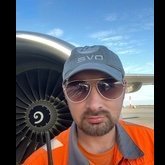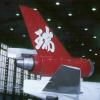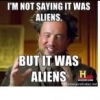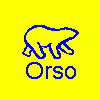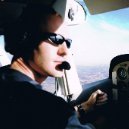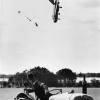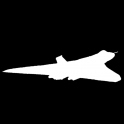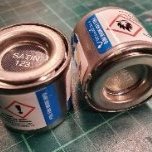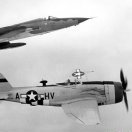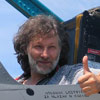Search the Community
Showing results for tags '1/144'.
-
Welcome everyone involved in modeling and just interested as well! So.. this is my first "adult" airliner model. All previous attempts better to be called just "baby-toys". It was finished in fall 2021. Since my first practice in aircraft modelling I was in search of the way to get smooth gloss surface on my models. So finally I've discovered the way, that I use till today. It's easy enough - for gloss white surface I use airbrush with Gunze (Mr. Hobby) H-1 paint plus thinner for acrylis paints mixed up to the consistency of milk. Boeing 737-MAX is well-known and popular airliner. Most of us know about some difficulties with this type, that caused two air crash episodes. The main visible differences between MAX and NG are new big engines and new form of IPU exit hole. There are also some additional differences, but they're clear only for technical or flight staff. This built take a lot of time - more than one month - it's really long for me. The reason was that I've ruined first decal-sheet and had to wait till new order will be delivered. Zvezda kit is well-known and really neat and easy-to build, needs just a few putty (I use Tamiya Putty basic type) for connecting wings with fuselage. Unfortunately, my kit had manufacturing defect: right wing was twisted. I tried to solve the problem using hot water. It was successfully for about 50/50. It's not rule for Zvezda, but an exception. Also I know, I'm "lucky" guy 🤦♂️ First I've used ZIP-maket primer (really cheap but low-quality thing, later i refused from using it) Basic white, as I told upper, was Gunze H-1. Red-nose and winglets is master-acryl #12 Wing edges are painted with Tamiya X-11 chrome silver Undercarriage and wheels are MAKR #6 aluminium and Tamiya XF-85 rubber black. Flaps were highlighted with soft pencil. Gray color of wings mixed from Gunze H-1 plus a few dark gray Tamiya paint. Pledge future prior and after decals plus one additional layer for extra-protection. The livery I had choose once, while surfing model-store site. In my opinion it's one of the most interesting liveries (though some colleagues told it's odd and ridiculous). Very interesting idea with portraits of different famous persons on the tail. And mr. Oscar Wilde - is one of my favourite writers. "The picture of Dorian Gray" I've read two times, and saw cinema as well. His sharp quotes are brilliant! So it wasn't a long choice of person for Norwegian livery. Decals manufactured by Ascensio. Well and reach enough but too fragile. And another story that I've purchased two same sheets but white color of them was different. You can see it in word "Norwegian" for example. Technical inscriptions from default out-of box decal. Also there are some visible disadvantages I have made: -Sloppy painted engines - it was the most difficult part of painting for me - APU inlet is the same as 737-800 has. But really it's different. -Headlights on the wings also looks sloppy because first painted with brush in aluminium, then black and clear detail from the kit was mounted finally. - Too shiny (caramel effect) on the surface (That time I didn't use any flat base and covered model with 100% Pledge Future) Anyway, it was first warmy welcomed model on local thematiс resources. And now I'm glad to introduce it here. Feedback and criticism are welcome! Respects, tMikha.
-
Hello there! This is my first model on this resource, so i apologise if I have made some mistakes. So... all of us well know about A-320 plane - it's one of the most popular in the world. Model produced by Zvezda is very good about assembly and copyability. Some info about prototype: EX-32007 serves now in Kyrgyz republic Avia-Traffic Company. This is one of the oldest A-320 flying till our days - this plane in service since 1993. First operator was Sri Lanka airways. During that time plane was damaged in Colombo airport by terrorist attack. Later it was repaired and served in Danish air transport. At least in 2016 it was delivered to ATC - Avia-Traffic (ATC) based in Manas airport, Bishkek. In early march 2022 I've bought tickets for Aeroflot from Moscow to Bishkek (my parents live there). But for well known reasons, Aeroflot had temporary stopped flights to any foreign countries. And the only way to travel was ATC. So after good vacation with family, I had no doubt about livery for my new model. Materials: Zvezda kit 1/144 Decorix primer first Mr. Hobby H-1 for basic white Master-Acryl "royal blue" (Zvezda MAKR) paint for engines Also used some mr Hobby and MAKR (grey, aluminium) paints for wings, hot part of engines, undercarriage. Painted with airbrush. Decals ordered from avia-decal (Belarus) Pledge Future as basic lacquer and as well as a cover for decals. Final lacquer is Pledge Future mixed with 5% of Tamiya X-21 flat base. It's something near gloss lacquer, but helps to prevent excessive shine while photosession. PS Hope you will enjoy viewing this model. With respects, tMikha.
-
Another of Airfix’s classic airliner kits, I made this one straight out of the box. I was surprised to find it’s as big as a 707, I always thought those were much bigger! Sprayed with appliance white, chrome silver and Tamiya light ghost grey, detail touched up with Posca pen. The decals were very good despite the age of the kit. It needed noseweight, but generally the fit was quite good.
-
A bit of a late start but I think that I should be able to wrap this one up before the GB finishes. With plenty of military aircraft being built I decided to switch from my original plan to complete an Airfix Shackleton MR.2, bought as a gift by Mrs N when it was initially released, and join in the fun with this very British subject. The kit decals look a little fuzzy around the edges so I have ordered a set from 26 Decals which are on the way. Here are the box and contents shots. by John L, on Flickr by John L, on Flickr by John L, on Flickr by John L, on Flickr John.
- 28 replies
-
- 9
-

-
- Roden
- 26 Decals.
-
(and 1 more)
Tagged with:
-
This was a kit that I searched for a long time. They are rare these days and often change hands at ridiculous prices. This one I got on a Swiss auction site for a reasonable price,not cheap though... It was the 1985 Revell issue. Its the same mouldings as the Otaki kit,just this time in the Airbus house color markings. The decals were yellowed,so I ordered a replacement set from BSmodelle. The cheatline on the new sheet seemed too wide,so I used the Revell ones instead and only used the numbers and the titles from the new sheet. The kit has only a few parts,not very detailed but it has nice recessed panel lines and the fit is mostly fine. I improved the engine outlets as the kit ones were plain and also wrong in design. Photos of the original showed the outlets are pretty roughly installed. This was created by using plastcard plates and tubes. After the assembly,the whole model was sprayed gloss black as a baae coat for the metallics. Here I used Testors aluminium and silver and Gunze duraluminium to give some nuances. I tried not to overdo it because the real thing has a quite smooth metal surface. Airbus used 4 Super Guppies for transporting all kinds of parts for the A300,A310 and probably also the A320. They served fom the mid 70s to the early 90s,when they got replaced with the bigger Airbus Beluga,which is a heavily modified A300-600. Super Guppy No.4 is still flying today,with NASA,while the others are preserved in Toulouse and Hamburg. One was lost in an accident. Alex
- 17 replies
-
- 54
-

-
Back in the year 2000,Revell USA released their ancient Boeing 707 kit as Boeing 720. The first issue dates back to 1964,as they released it as KC-135 Tanker/Transport. Since then the kit appeared in many different airline markings,none of which of course resembled the real thing. Revell's 707 comes, if anything, closest to a 707-120. For this project,I decided to try to modify the kit as good as possible to produce a 720. The fuselage was shortened in front and behind the wings,counting the recessed cabin windows,compared to the real thing. Some slight adjustments were unavoidable to get the fuselage segments seamlessly back together. So there is a 2mm discrepancy in length to its 1/139 scale. But its as close as possible you can get with that kit. The main gear wheels I replaced with wheels from a Revell 747-100. They have the same size to the kit parts but are far more better detailed + the original wheels suffered from poor moulding. The cockpit was replaced with a DACO canopy to correct the front section. The kit features just window holes and looks completely off.Some later releases had a clear window part and there the shape was quite right. The rest of the kit was built OOB. The most challenging part was the painting,esp. the wings. Research on the net showed many different color patterns on the 720,even on United aircrafts,so I picked what I thought looked the most interesting. The silver/white on the fuselage was done with masks.I copied the decals and used the paper copies as layout pattern. The cheatline decal is printed with the blue,white and gold as one unit. I remembered from an earlier attempt to build this kit,that the white is not opaque. So here I decided to trim away the white parts. As I had shortened the fuselage,the decals had to be trimmed as well. I used first the copies to find out where to cut and create the correct layout. That worked out well and only slight touch ups were needed Paints are my usual brands,Gunze,Tamyia,Testors. Its not 100% accurate but I am quite pleased with the outcome. For a more accurate Boeing 720,there is the Roden kit. It was an interesting and fun build,despite its issues I like those Revell 707 wanabees Something new for the photoshoot...the runway is from the Hawk/Round 2 Comet kit Alex
-
Here is my finished Boeing 757-223(WL) in 1/144 scale from the Zvezda kit in the new livery from American Airlines registration N185AN. This kit goes together seamlessly with very little sanding and filling required. It’s great that is has both engine options as well as having either the newer blended winglets or the classic wing tips. I’ve never built the Minicraft or EE kits but I absolutely can’t recommend this kit enough! The decals are designed by Backdoor Decals and purchased through Nazca Decals. The coroguard section and detailing is from the Nazca Decals B757 detail sheet. The paint mix I went for was mixing Revell light grey 371, Revell white gloss 04 and a touch of Revell Silver 90. It was a case of keep mixing until I found a shade I was most happy with. It was then brush painted. Then I used Halfords Racking Grey for the wings and stabilisers. Metals are a mix of Revells aqua range. The decals are excellent quality and I highly recommend them! As always, all comments and feedback is greatly appreciated. Thank you for looking. Regards, Alistair
- 13 replies
-
- 36
-

-

-
- 1/144
- nazca decals
-
(and 1 more)
Tagged with:
-
These two kits were started in early 2021,but just got finished recently. 2020 saw the 50th anniversary of both the Lockheed L-1011 TriStar and the McDonnell Douglas DC-10,so these were built,a bit late I know 😊 ,as part of my anniversary builds. The DC-10 Demonstrator is already here on the RFI. This is the original Otaki kit released somewhere around 1970-1972 and is the most accurate TriStar injection moulded kit. They are being sold for silly prices on some well known sites because of their rarity status. I did not mention the Eastern Express kit here,because its more or less a copy of the Otaki kit,with some slight modifications and added parts.The exception is the -500. It features recessed panel lines and lots of details everywhere on the parts. They are a tad too deep,but nothing that sandpaper cant fix and with paint on,its quite ok. A nice feature that comes with the kit are the air stairs.Otaki provides not only one but two ! and also a display stand is included. The decal has options for the TWA twin globe livery and the All Nippon Airways "mohican" livery. They are nicely printed,a bit thick though. Due to their age,the carrier film has a bit yellowed but otherwise they are fine. For my builds I chose the Demonstrator version and the Air Canada delivery scheme. The demonstrator decals are from Classic Airlines by Nick Webb. They are of good quality,durable and fit on the model with just minor adjustments. Some extra parts are included if something goes wrong or does not line up properly. The Air Canada decals are from 26 and are wonderful as well. A big plus there is the detail sheet with everything necessary provided. The windows are from Authentic Airliners. Paints are from Tamyia and Gunze. Cheers Alex
- 21 replies
-
- 44
-

-
- Lockheed TriStar
- Airliner
-
(and 1 more)
Tagged with:
-
This was an airline that I wanted to have for a long time. I flew with them on one of their A340s from Zurich to Saigon in 2018 and was impressed by their service standard. I planned to make one of my A340 kits with that livery but unfortunately the decal set from 8a decals was out of print. So I looked for the Revell A320 kit with those decals instead. It took a while to find an affordable one but I managed it finally. But I wanted it a bit different,so I used a Zvezda A320 kit,which offers a nice cockpit,options for an open door and lowered flaps. Its depicting something like a maintenance check,but I havent got some ground equipment for it yet. The cockpit is necely detailed but I added arm rests to the seats,thrust levers to the middle console and painted on the display screens. A logbook was placed behind the co-pilots window to add something extra. The entrance was enhanced with detailed painting and the blue carpet was created with Tamyia masking tape. After closing up the fuselage,not much of the work can be seen though....😳 The flaps and slats construction is a bit complicated explained in the instructions,so some research and photo reference of the real thing was needed. The construction itself is easy as the parts fit very well. Painting and weathering was the most work on this project. Careful masking for the red front to get it symetrically was tricky. Paints are Gunze white primer 1000,clear coated with Gunze Premium Gloss. Gunze gloss red,wings are painted with Testors aircraft grey mixed with white.Coroguard panels are from the Zvezda decal sheet. The "Edelweiss" billboard had no window openings ,no idea why Revell did it this way.Their decal sheet only provides silver frames for the windows. As I opted for open windows, I applied the decals over the windows,then clear coated them.After dry I used a new sharp blade and cut out each window, then filled in the windows with white glue.After that the silver frames were applied. This is one of my most sophisticated models to date,for my first time doing all these things,I am quite pleased with the result. Alex
- 22 replies
-
- 32
-

-
Due early May https://modelsua.com/boeing-rc-135v-w-rivet-joint-c-135-1-144-roden-349
- 31 replies
-
- 10
-

-

-
Hi, Here's my GWH Victor that I'll build as an all white Victor of No 100 Sqn. I've built XM715 before in this scale as a tanker at the end of her career. These two models should look interesting together. I know that I talked about entering a 1/144 Argosy in this GB, but I simply have too many unfinished models to work on. Cheers, Stefan.
-
For a quick build of a kit I bought as an eBay bargain I’m very pleased with this. The kit dates from 1980 but mostly fitted together really well despite its age. I filled and sanded over the windows and used decals instead, but otherwise it’s out of the box.
- 15 replies
-
- 23
-

-
Paul who is building this kit over in the WIP section asked for some pictures of my kit. It is a kit that I built as a teenager. Airfix 1/144 scale. I remember that I struggled to get it finished before a set date. I managed to finish it very late December 1978. 350 years after it went to the bottom. The model has survived surprisingly well. For a long time it was in a box in the basement and parts of the rigging has came loose just hanging in the threads but now it is collecting dust high up on a shelf. I have bought a second kit a couple years ago that I intend to build some time.
-
Here's an OOB build of Trumpeter's 1/144 Avro Vulcan. The build is straight forward with excellent fit. Painted with Tamiya acrylics and finished with satin varnish. She's a big girl.
-
I recently finished the second of two 1/144 models of somewhat obscure Sikorsky flying boats which I thought might be of wider interest here. The silvery one is the XPBS-1 and the camouflaged one is the VS-44A 'Excambian'. Both were build from the Anigrand kits and I used the absolute excellent reference book reviewed on BM here. Invaluable, even in the age of the internet (does that make me sound old?). Background These are both pretty niche but fascinating aircraft, forgive a bit of context... The XPBS design emerged first from a 1935 US Navy request for a new long range patrol bomber larger than the Catalina, with better performance and more bombs and guns. Both Consolidated and Sikorsky submitted proposals, and the XPBS-1 (dubbed 'The Flying Dreadnought' seemingly by nobody other than Sikorsky's marketing department) first flew in 1937. The Navy accepted the Sikorsky aircraft, even though the contract went to Consolidated for what became the Coronado. But the Sikorsky prototype was retained by the US Navy and between 1939 and 1942 it was assigned to a Naval Transport Unit flying staff between San Diego and Hawaii. It crashed when it hit a submerged log in 1942, sank and was lost. Admiral Nimitz was lucky to escape from the wreckage with his life. It's a funny-looking thing. Quite aggressive, with that jutting jaw. As my brother said when I showed it to him - "it's like an ugly Sunderland". Apt. From the XPBS, Sikorsky developed a civilian version, the VS-44A. Basically, when the Navy rejected the Flying Dreadnought, Sikorsky pitched it as a civilian airliner. It secured a contract from American Export Airlines (the air subsidiary of a major shipping company, American Export Lines... see what they did there. Golly branding was uncomplicated in those days). The three VS-44s were delivered to AEA after Pearl Harbour and were rapidly repainted into US Navy colours and designated, as far as the Navy was concerned, the JR2S-1, though AEA retained each aircraft's official name: Excalibur, Excambian, Exeter (also the names of AEA's flagship sea vessels). I love that that bit of the 'Golden Era' of air travel lived on amid all the drab camouflagery. The VS-44 exceeded all of its design expectations - being faster and with greater range even than the larger, more famous Boeing Clippers. During the war, Excambian - as I've built here - flew back and forth across the Atlantic and was the only aircraft in US service capable of doing so non-stop, establishing some notable records at the time for the fastest crossing. It ferried VIPs, cargo and mail, both on the main New York to Ireland route, but also from Bathurst (now Banjul, The Gambia) to the Caribbean, and around Latin America. Humphrey Bogart hitched a lift in one, as did Eleanor Roosevelt, Admiral Andrew Cunningham and General Omar Bradley, along with Dutch Queen Wilhelmina (incidentally, one of the few monarchs to reign during two world wars - quite a character). Many of the pilots for AEA were also former AVG Flying Tigers, which I didn't know. So a pretty hot airline in its day - somehow also crying out to be the setting for an Agatha Christie novel. Very 'Orient Express'. It was helpful for the Navy to be able to contract out some of this transport duty to AEA, both to free up Navy planes to do war stuff but also because, technically operating as a private company, AEA could land in neutral ports (like Foynes, Ireland). But by 1944, this was less essential and the Navy had enough long range aircraft to operate its own air routes, so AEA's contract was cancelled in early-1945. In June 1945, AEA merged with American Overseas Airlines (what is now American Airlines) which saw little future in flying boats given the vast increase in the number of landing strips across the globe during the war. Probably quite sensibly, it put its dollars into a fleet of DC-4s. In late 1945, Excambian and Exeter were put up for sale. Postwar they were operated by a hotchpotch handful of owners before Exeter crashed gun running for South American rebels, and Excambian essentially became derelict. The sole survivor of the 'Flying Aces' as the three were known, Excambian has since been restored and is now at the Connecticut Air Museum. Which I shall visit some day and bore all of the museum staff rigid. Builds Both are built from the Anigrand kits released in the last five years. Anigrand also produces a 1:72 version but 1:144 is my poison. Neither were complicated or particularly challenging, and I enjoyed both building them and learning about something new. First the Flying Dreadnought And it's younger, sleeker cousin. Both builds were fairly straightforwards (though there is one flaw on the VS-44 that I failed to correct to do with the inboard nacelle shapes) but happy to answer any questions. Full build threads for both are here and here for any that are interested. Hope that might be interesting or helpful for someone. Thanks very much for looking! Angus
- 18 replies
-
- 51
-

-

-
For the currently ongoing Bomber/Strike/Ground Attack Group Build my entry was a Mikromir Handley Page Victor. Mikromir is a Ukrainian short run kit manufacturer, their kits don't fall together like more mainstream brands' kits might. They need some care to get right, but you can get some fantastic results from them, especially the more recent releases. This kit was released in 2019, and I previously bought and built one shortly after the initial release. Since then my modelling skills have moved on and developed a lot so I wanted to give the kit another go, and also of course just wanted to add another Victor to my collection of V Bombers. I decided that this would be built as an early Victor B1 in the original white scheme featuring full shade markings, before the pale versions were introduced. I chose XA935 because there are a good number of available reference images and it lacked squadron markings at one point in 1959, which is what I was after. I think it is rather fitting that my first completion of 2022 is a Ukrainian kit. The build thread is quite disjointed due to long gaps when I was at uni, so I have summarised the build here instead. The original thread is here if you want to read it: The Build The box art of this kit is a painting of Victor B.1a(K.2P) in its 1970s scheme, the real XH648 is currently in its final phase of restoration at the Imperial War Museum, Duxford; it is the only surviving Mk1 Victor. Included are decals for three aircraft: XA940, XH592 and XH648. There are a few mistakes here; XA940 was just a B1, in fact it was the only camouflaged B1, it never had any tanking mods; XH592 was a B1a, it too had no tanking mods; XH648 is a B.1a(K.2p) referred to here as a K.2P (not incorrectly, this designation was sometimes used before the K2 was introduced), however the instructions would have you build her as a K1a. XH592 and XH648 can be built fully correctly with only kit parts by just choosing the right ones, XA940 needs a small modification which I will get to later. Construction of the model went fairly smoothly, interrupted by university though. Due to its short run nature, careful assembly was required throughout the build. Every part needed adjustment to fit correctly, but once these adjustments were made most of it fits well. There are no alignment pins in the kit, so plastic card tabs are essential to get parts lined up properly. Small amounts of filler are needed with most joints, but few joints required a significant amount. The intake inserts are some of the most filler hungry components, the internal seams aren't too bad but they don't quite sit right in the wing. Speaking of the wings, this is where this build becomes a bit more me. If you know anything about what I like to build, you will know that I like to modify kits with all sorts of conversions and corrections. The wings in the kit represent the later version with an extended, drooped leading edge. Originally Victors were built with leading edge flaps, but following the findings from the tragic loss of XH668, the first B.Mk.2, they were refitted with the fixed extensions depicted in the kit. To build mine in the configuration I wanted, I needed to convert the wings back to the original design. All this required was sanding back the leading edge, reprofiling it and rescribing the panel lines. Here the wings were marked with tape along where I needed to take the leading edge back to. Replacing the kit's photoetch airbrake fins is a must. The upper fins are larger and the lower ones are more of a ridge. The kit supplies two sets of upper fins. Plastic card was used to make new ones, the upper ones using the etch parts as a template and the lower ones just being thin strips. After fixing some damaged parts, assembly was completed. My standard process for painting V Bombers in white is white primer, in this case Tamiya, followed by a medium grey pre-shade a couple of coats of Halford's Gloss Appliance White. From there the details were painted in, decals were applied using tape as guidelines to align them properly. The landing gear was added, which I think is overengineered with 17 parts on each main gear, or 9 if you don't include the wheels. In 1:144 scale that is simply too complex, and not particularly durable. It's one of only a few points I will criticise on this otherwise good kit. The penultimate step was adding a gloss varnish to protect the decals and make them as shiny as the Halford's white. And finally to finish the build, a panel line wash was added. My taste is for darker lines, I know this isn't to everyone's taste, but it's how I like my models to look. The Finished Model Finally, with the model finished after four months of on and off work, here is the final result: A few with the stand I made for my first Mikromir Victor. I think I'm going to have to make another of those, it's a modified ICM stand and I think I have a spare around somewhere. And of course, the full set of V Bombers in the early version of the anti flash white scheme: Replacing the Vulcan B2 with a Vulcan B1, albeit a bit smaller in 1/200 scale. The three Vs in their original production variants With pale markings I have a Vulcan B1a in the right scale And finally with a more recent, better quality build of a Vulcan B2
-
After a hiatus of a few weeks, I’ve decided to give modelling a go again, this time with a civil airliner. I got this DC-10 on eBay for a bargain £20, not realising the price reflected the fact it has been started. However, it’s not too bad, with just the bulkheads glued in and one engine pod built, so I’m going to plough on. Oh and the windscreen is snapped in two. I actually really like the American Airlines scheme, that all over silver looks pretty cool. How is one supposed to deal with the decal covering all of the passenger windows though!? I can’t apply it before I fit the body together as it’ll be a nightmare to paint without ruining the decal, but if I add it at the end, I won’t be able to poke any window holes through. How do people do this? Or is it better to find some window decals and don’t bother with the transparent parts except to fill the fuselage holes in? Can anyone help?
- 29 replies
-
- 6
-

-
I was curious to make some of these MKM 1/144 scale kits. My thinking was that being tiny scale, not only would it stand a chance of fitting in my house, would also take less time to build and frankly be less of a loss when my first attempts at new techniques inevitably went horribly wrong. This thinking, as I'm sure you all already know, has its flaws; half scale does not equate to half the build time! I also have a soft spot for the scale since by childhood bedroom was adorned with a range of academy minicraft kits hanging from the ceiling. Anyway, so far it's been a nice kit. It has something of the whiff of limited run of course, but mostly has come together nicely. The issues are that I've used it as a test bed for trying out techniques for the first time and the results have been predictably dodgy. It thought this would be a good place to get some advice! Here's after closing up. Note the trademark acetone spill on the wing. The port oil cooler pinged off into the carpet, so is now some sprue with a rather rough hole drilled in the front. It could do with more shaping, but I'd rather lost interest in tarting it up at that point. The plan was originally to brush paint this when away from the spraybooth (small enough to take with me during weekends getting free child care at the parents' house!), but it's evolved into my first experiment spraying humbrol enamels (which, being a child of the 90s UK, I have something of a soft spot for). I've had a lot of problems getting the mix and pressure right, possibly because the paint is hard to measure and dissolves rather reluctantly into budget white spirit. Anyway the Sky and EDSG went on okay (over Mr surfacer 1500 IIRC). Dark slate grey before EDSG would've been the sensible choice but I was as yet unsure whether or not I wanted the TSS camo. So far so good (enough) Now was perhaps the point of particular genius on my part. Not content to just try a new paint type, I thought I'd also try with a new technique: freehand camouflage. Setting aside that this is entirely the wrong scale to use such a technique, I ploughed on regardless. I had all kinds of issues with tip dry, un-tip dry, sudden splatters, underthinning, overthinning, having to go back over it with EDSG. The results are here for your comedy viewing pleasure. Please be aware, there are pictures following that some viewers may find distressing. Oh god my eyes. The splodging and necessity of going over it so many times also led to the predictable result of lots of bleeding and seepage around the demarcation masks. So at this point I was deciding whether I could be bottomed to strip it back to plastic and start all over again. I couldn't. Instead I thought I may as well whack some Gunze GX100 on it randomly to see what happened. This happened. Oddly enough, the colour (though certainly not the surface) evened out somewhat. I had a cursory hack at bringing back a little with some fine sandpaper, and then in a further spasm of 'meh whatever', slapped the decals on it. and battered the thing with GX100 again. Clearly we're not getting any awards for this one, but I'm kinda amazed how comparatively un-horrific is has become. Of course now I've got to actually go and clean up all those shonky top/bottom demarcations. Right now I'm sanding back the decal bumps and generally trying not to think about the spindly landing gear that I've mostly already snapped. So there you are. It's been a fun learning experience so far for me, getting a little more experience about where the line is between binning it and ploughing on with your hands over your ears going 'lalala I'm not listening'.
- 9 replies
-
- 9
-

-
- 1/144
- Mark I Models
-
(and 1 more)
Tagged with:
-
My newly completed F-14 Tomcat VX-4 'Vandy One'. The kit is Revell 1/144 scale and the model is brush painted with acrylics. It was a very nice kit, original Revell moulds that went together easily and a very detailed set of decals that really brings it to life, which you don't always get with 1/144 scale. The hardest part was painting the black plastic white for the undercarriage and missiles, I lost count of the number of coats I painted. I've also incuded a picture with the Revell 1/144 MiG-31 as a fun size comparison. Thank you for looking!
-
This is the new Revell tooling of the A321NEO. For their A320NEO and A321NEO ,Revell decided to create a complete new tooling and not only pack new engines in an old boxing. This was a good idea,because their older A320/321 kits had a few errors and became also more and more worn out. The new kit is a real treat Everything fits snuggly,the parts layout is very well done. It took me 2 afternoons to build the kit,no filling was needed,except the windows,so the painting could begin almost immediately. This was also a straight forward task. Fuselage all black,then gloss coated with future. Wings the usual greys and aluminium for the leading edges. I actually planned to have clear windows,until I found out that Air New Zealands A321NEOs have a different windows/door layout... Until then I thought Airbus only has one layout except the number of emergency exits.Well...you always learn something new... The decals are from PAS decals and are nicely printed and opaque even on such a dark surface,something I had worries about in the beginning. The windows are again from Authentic Airliners and all details come from the great Revell decal provided with the kit. A very relaxing and quick build. Cheers Alex
- 35 replies
-
- 46
-

-
My first Zvezda 757 build ,and I have to say it is a wonderful kit that goes together perfectly. Almost no filling required,all parts fit neatly. I had actually plans for the 757 with the Phoenix Suns livery but the seller sent me the wrong sheet although the correct instructions. While I checked photos of the Diamond Backs livery I found it also very attractive,so I decided to keep the decals and build it in this livery. The greenish fuselage colour had to be mixed. As these paints were Humbrol flat paints,I clear coated it with Future,as my usual Gunze varnish wasnt enough to get a smooth surface for the decals. The decals are Brasil Decals,they offer a great variety of liveries and the quality so far was quite good. But here the decals,esp. the red/gold stripes didnt want to stick on the model and most of the elements tended to silver after dry. Lots of careful trimming away the clear film took care of the silvering,not perfect but a lot better than without. Some elements overlay,so I clear coated them between each step to ensure that they will stay on the model. Some trimming was necessary as the decals are actually meant for the Minicraft kit. The windows are from Authentic Airliners and details are from the kit and a 757 detail set. Its in my opinion not quite up to my usual standard due to the problematic decals but it looks good in the showcase. Cheers Alex
- 19 replies
-
- 25
-

-
Here are the photos of old Revell model of Boeing 727-100. I engraved the model. I installed a transparent part of the cockpit from the Daco model of B-737 to improve the shape of the nose
- 5 replies
-
- 22
-

-
- Boeing 727
- Revell
-
(and 1 more)
Tagged with:
-
Here is my finished Boeing 757-236 in 1/144 scale from the Zvezda kit in the ‘Animals & Tree’s’ World Tails livery from British Airways registration G-CPEL. The aircraft entered service in April 1989 with Air Europe. It then joined the BA fleet in August 1992 where it served passengers out of Gatwick and Heathrow. It was then transferred to FedEx in June 2010 where is was given registration N946FD and is still active with them today. This kit goes together seamlessly with very little sanding and filling required. It’s great that is has both engine options as well as having either the newer blended winglets or the classic wing tips. I’ve never built the Minicraft or EE kits but I absolutely can’t recommend this kit enough! The beautiful decals are from Ray at 26Decals. The Animals and Tree’s livery originated from Botswana and was designed by artist Cg’ose Ntcox’o who is of the Ncoakhoe People of the Kalahari Desert and the design depicts seven jackals at an oasis. It was wore by 7 other aircraft in the BA fleet around the same time. Paints used were Halfords appliance white for the upper fuselage, Halfords Fiat Capri Blue for the lower fuselage and engine nacelles and Halfords Racking Grey for the wings and stabilisers. Metals are a mix of Revells aqua range. The decals are excellent quality and I highly recommend them! I am already working on a few more BA liveries, the B767-300 in the Chelsea Rose livery and a B757 in the Landor livery. As always, all comments and feedback is greatly appreciated. Thank you for looking. Regards, Alistair
- 15 replies
-
- 34
-

-
After 7 months of work, more or less without long pauses, i manged to finish this bird. I have actually no realtionship to the plane, i just liked the livery and i remember seeing it until 2013 in TLV, when we had nightflights to israel. So allthough some people say this kit is more or less flawless, i found quite some errors i had to correct. But in general this kit is inline with other zvezda products. First thing i noticed zvezda obviously was very keen on releasing the kit, probably as much as we modellers were awaiting it. My kit hat a trapped air bubble in the windshield and a short shot MLG. Both things were corrected, one easier and the other one....well - not so. So i started making a copy of the windshield by crafting a silicone mold and casting clear resin with some green/turquoise dye. The short shot MLG was simply fixed with styrene plastic. here is the link for the WIP things i corrected, added or modified: - Clear resin windshield with the typical turquoise colored glas - Full cockpit including customized pilots - Cabin windows casted into the fuselage - Added window blinds - Closed APU exhaust and added a proper exhaust pipe - Added outflow valve case and flap - Replaced all lights with clear parts and lenses - Corrected panel lines at the tail section (zvezda missed one on one side) - Scratched panel lines for the nose gear doors - Added radio altimeters with plastic styrene - Added repair patches on aft fuselage - Added 2 antennas on roof top - Masked most of the livery, except for titles and registration - Made own decals for a few stencils (trim scale) and the registration - Scratch built MLG wheel wells incl. hyd lines - replaced wheels with some resin wheels (bought somewhere in russia...don't ask the brand, can't remember) - Added hyd lines to the MLG - Added Beacon lights, scratch built - Added static dischargers made of brush hair (counted all of them...hate it) - Scratch build all antennas in 0,3mm styrene paper - Added Authentic Airliner etch part pitots and Authentic airliner wiper decals - Masked the cockpit metal frame with own designed masks i probably forgot a couple of things, but those are the main things. If you are interested check out the WIP... this time i made videos on youtube. So, here are the pictures, i hope you like it.
- 18 replies
-
- 35
-

-
My last Star Wars logo jet. I had this one finished some weeks ago but not yet photographed for the RFI. Now here it is finally. The build was straight forward without issues like the other 777s. Most fiddly parts are the landing gears with their detailed but also tiny parts. The decal sheet is from BS MODELLE. I used decals from him before,so I was a bit surprised with the problems I faced here. Some decals are wrongly designed and shaped so lots of cutting and aligning was necessary. Some elements were impossible to get in the exact location otherwise issues would occur in other places. It doesnt affect the overall appearance so I can live with it. The windows are from Authentic Airliners,details from the kits decals and spares. Paints are Gunze white primer for the fuselage,gloss coated with Gunze Premium gloss before and after decaling. Grey is Gunze grey 315 and metallics are Gunze chrome,aluminium and burnt metal. I wanted to take a group shot with all 3 Star Wars themed models but the space was not big enough...😊 May the force be with you Alex
- 12 replies
-
- 27
-

-

-
- Boeing 777
- Zvezda
-
(and 1 more)
Tagged with:

